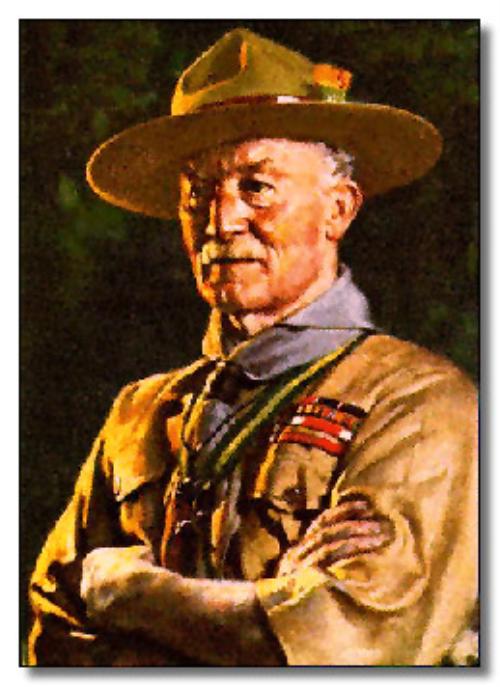
With the early success of the Boy Scouts for boys 12 and over, there was popular demand for a "younger boy program" for the siblings of Scouts. In 1916, Sir Robert Baden-Powell introduced the "Wolf Cub"program for younger boys. This program soon found its way to numerous communities in the Americas. There were also other 'younger boy' organizations such as the "Little Lodge" of the "Woodcraft Indians, "the "Boy Pioneers," and the "Boy Rangers." Some BSA Boy Scout Troops were also sponsoring unofficial "Junior Troops" and "Cadet Corps.
"The Boy Scouts of America was incorporated in the United States by Congress on February 8, 1910. After 20 years of successful Boy Scouting in America, "Cubbing" was initiated on February 10, 1930.Cub books were issued including: Wolf, Bear, Lion, Parents' Cub Book, and Cub Leader's Outline. Uniforms for boys were issued ($6.05 complete) and 5,102 boys and 1,433 pack leaders in 243 packs were registered during the first year. At the end of the second year, 25,662 boys were registered in Cubpacks in 258 councils across the nation with 5,228 registered pack leaders. The leaders at first were all male. In 1936, den mothers were added. In 1938, the Bobcat pin and rank was added.
In 1940, Cub Pow Wows were introduced as a training medium for adult leaders. In 1941, the Webelos rank was created for 11 ½ -year-old boys with the Lion badge. There were 335,775 boys registered and 56,691 pack leaders.
In 1943, the first Blue and Gold Banquets were held. In 1945, the name of the program was changed from “Cubbing” to “Cub Scouts.” To help during the war years, packs sold War Bonds and War Stamps, and collected grease, newspapers, and milkweed floss. Many packs had Victory Garden programs. In 1949, the age levels for Cub Scouting were established as 8, 9, and 10 with boys entering Boy Scouts at 11 years of age.
In 1953, the first 'un-official' Pinewood Derby was run on May 15 by Pack 280c under Cubmaster DonMurphy. Cub Scouts donate 2,889 pennies for Korean Scouts plus "tons" of used uniforms. Registrations: 1,606,249 boys, 570,751 pack leaders. In 1954, the Webelos den was created for 10 ½ -year-old boys. In 1955, the first ‘official’ Pinewood Derbies was introduced.
In 1964, the National Summertime Award was created to encourage year-round Cub Scouting. In 1965 Cub Scouting broke through the three million mark for the first time with registrations during the year reaching 3,031,137 boys and 1,075,863 pack leaders.
In 1967, the Lion rank was discontinued in favor of the new Webelos Scout program with its distinctive uniform and 15 activity badges. In 1968, Cub Scout Day Camps were begun. In 1972, embroidered badges for Bobcat, Wolf, Bear, Webelos which moms love to sew on. In 1978, the Arrow of Light rank was added.
In 1980, the 50th anniversary of Cub Scouting in the United States was celebrated. There had been 30 million Cub Scout registered since 1930. New designer uniforms for boys and leaders were introduced including the blue Bear Neckerchief. Cub Scout Jason Sherman visited the White House on behalf of the over 1.8 million Cub Scouts then registered in Cub Scouts. In 1982, Tiger Cubs was introduced for 7-year olds. In 1986, membership in Cub Scouts was changed from age to grade in school with Webelos Scouting expanded to 2 years for fourth and fifth grades. (Note: In the LDS Church, membership is still by age.) In 1988, the largest national Good Turn since World War II was held in November when ‘Scouting for Food’ sent the BSA's youth and adult leaders into their neighborhoods to collect food for the needy. The harvest was more than 60 million containers of food.
In 1999, the separate Cub Sports and Cub Academics programs were modified and re-named Cub Scout Academics and Sports program. Garfield (the cat) was named as national Cub Scouting 'spokescat.'
On its birthday on February 10, 2005, Cub Scouting in America will celebrate its 75Th anniversary. Since it’s inception, over 50 million boys have been Cub Scouts in the Boy Scouts of America. No program inhistory has had the far ranging impact on American youth than Cubbing and Cub Scouting have!
Baden-Powell's Legacy
Although Scouting has changed over the years, the ideals and aims have remained the same: character growth, citizenship training, and personal fitness. Scouting is updated periodically to keep pace with a changing world. It isn't the same as it was on Brownsea Island in 1907, but the ideals are still based on principles that Baden-Powell had been taught as a boy.
Scouting's founder was never able to completely overcome his surprise at Scouting's worldwide appeal. As it swept the globe, Scouting brought him new adventures and responsibilities as Chief Scout of the World. He traveled extensively and kept in touch with Scouting around the world.
Eventually, Baden-Powell's health began to fail. He set up a winter home at Nyeri, Kenya, in 1938, where he spent his remaining years until his death in 1941. Scouts of different races carried him to his final resting place in the small cemetery at Nyeri. His grave is marked with a simple headstone that bears his name and the Scout sign for "I have gone home." Today, in Westminster Abbey, a tablet records his name, along with the names of some of the greatest Britons of all time.
After Baden-Powell's death, a letter was found in his desk that he had written to all Scouts. It included this passage: "Try and leave this world a little better than you found it." These words are a fitting epitaph, for as he won the respect of the great by his strength, he won the hearts of youth by his example.